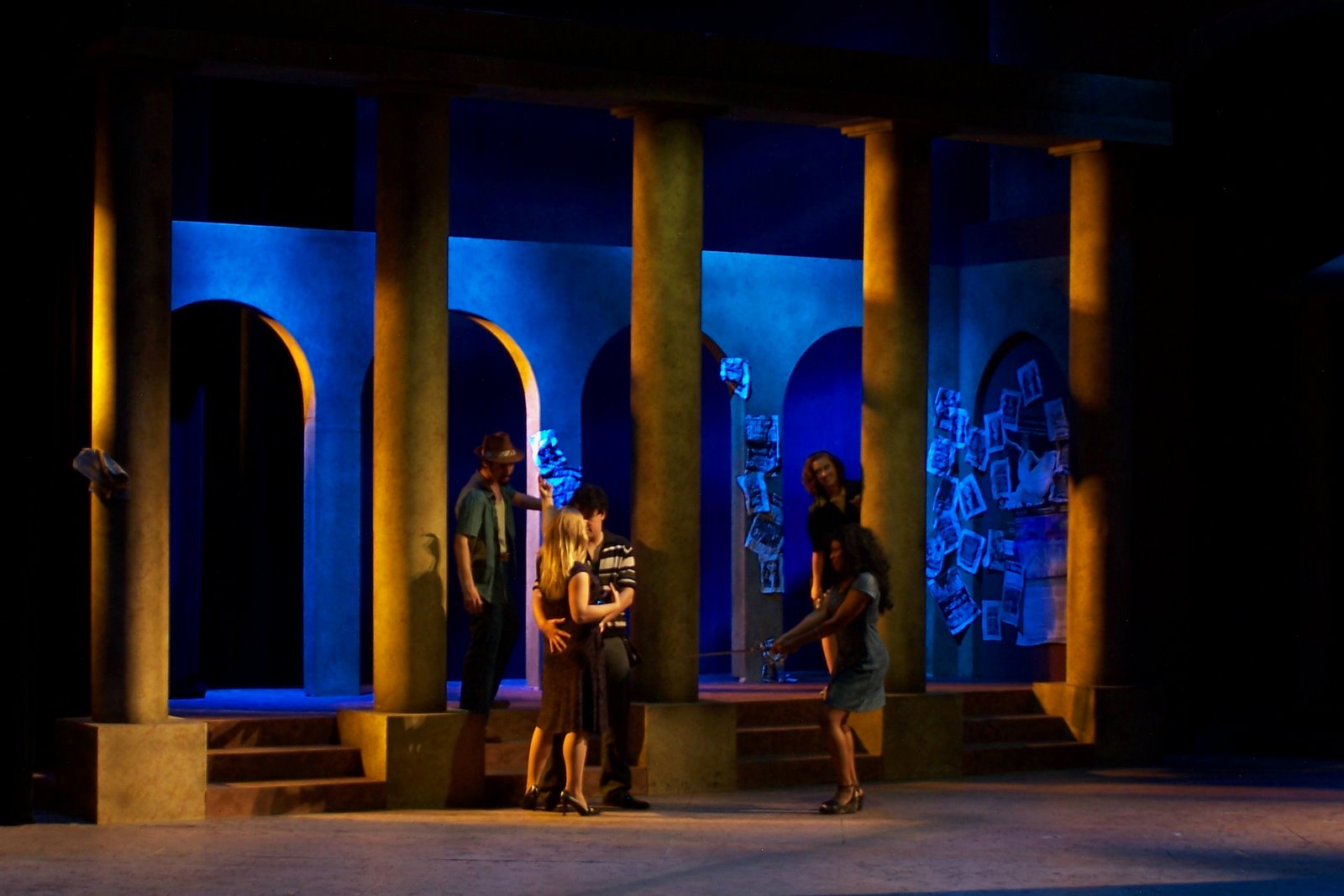Jay Donly, Sarah Leahy, Brian Carbine, Luna Alexander, Patrice Cross. Photo and lights by Jeromy Hopgood.
If
you wanted to throw my whole theory about the cause of the feud out of
whack, you could point out to me that Lady Montague does not, in fact,
have the final death in the play.
I would answer with a nod, a sigh, a smile. “I know. Benvolio does.”
The
first legitimate publication of Shakespeare’s plays was the First
Folio. Put together by his actors after he died in a wonderfully
mercenary attempt to raise cash, it sets down in print together for the
first time the Bard’s most famous plays.
But
there are discrepancies. Because of the expense involved in copying out
a play, only the prompter or stage manager would have had a full text.
Actors had their cues, their lines, and their stage directions, usually
worked into the text. So when Condell and Heminges tried to put
together 36 plays, there were several missing. Some they reconstructed
by memory, or got lucky and the actors had held onto their rolls of
ink-stained parchment (where we get the word 'role'). Some they had
complete, thanks to a fastidious stage-manager. And some were taken
from the Quartos.
In publishing terms, a Quarto is the result
when four leaves of a book are created from a standard size sheet of
paper. Each leaf is usually printed on both sides, leaving eight
printed pages in total. In Shakspeare’s time this was true, but there
was another wonderful connotation – bootleg.
Today
when a movie comes out there are always some jerks in the audience with
video cameras, and a shaky version of the film shows up the next day on
the internet. This happened during Shakespeare’s heyday, too. Pretend
you’re an Elizabethan going to see, say, Measure For Measure. You’re
rich, so you’ve got a seat in the balcony. Down the row from you some
shifty-looking patron is sitting with a quill and inkpot, scribbling in
a fast shorthand every word the actors below are saying. A week later
you see advertised at a different theatre a play called, astonishingly,
Measure For Measure. There are no copyright laws, no redress or
remuneration for the author. That’s just the way it goes.
Sometimes
a Quarto would be published by the author, but far more often a Quarto
of some play would appear having been ‘stolen’ as it were from a live
performance. These Quartos sometimes have wild differences from the
Folio versions, as bootleggers often could not write as fast as actors
spoke. There were gaps that had to be filled in. If there are lots of
these gaps, caulked in with low verse and poor rhymes, you get what is
known as a ‘bad’ Quarto.
What has all this got to do with Benvolio? Because in the Second Quarto (the ‘bad’ Quarto, the ‘eeevil’ Quarto) of Romeo & Juliet, printed by Thomas Crede for Cuthbert Burby in 1599, Benvolio dies.
What? you cry aloud. How? Why?
Alas, I reply, we don’t know. Montague brings us news that his wife is dead. Then he adds, as if in after-thought, ‘And young Benvolio is deceased as well.’ No word of how or why. All we know is that no one makes it out of this play alive.
I
actually like this line. It gives me a lot of freedom as a director.
Several times now I’ve contrived ways to kill Benvolio in the latter
part of the play. My favorite is to have him meet a girl at the Capulet
party. Later, after Juliet has drunk her potion but before she’s found,
Benvolio meets this girl for an assignation. They embrace, but she
recoils at once. His sword-hilt is jabbing her. Sexily, she either
removes his sword belt or unsheathes the weapon and lays it aside.
At
that moment, unseen by Benvolio, Gregory and Sampson from the opening
scene creep up. Benvolio senses them, however, and puts up a desperate
fight. But he’s unarmed and is quickly killed. It’s a nice parallel to
the light-hearted melee at the top of the show. Then – ah-ha! – Lady
Capulet arrives to pay off her three servants, who then remove the body.
Lady
Capulet. She’s already told Juliet that she’s planning to send a poison
to Mantua and have Romeo done in. But she blames Benvolio for spinning
a web of lies around the death of Tybalt, despite the fact that he
spoke true. Would she let him, ‘a kinsman to the Montague,’ live? I
think not!
So there’s a peek at how my mind works, filling in gaps much like the bootleggers of Shakespeare’s time.
I
could refute the claim that Benvolio gets the final death by saying
that maybe he died days ago, while Lady Montague died this very night.
Maybe she sensed her son’s passing. Maybe she killed herself for her
part in the fued. Maybe she did in fact die of grief. Or maybe she and
Benvolio had a sexual-suicide pact and leapt naked off of one of
Verona’s forty-eight towers. The world may never know.
The photo at the top is from my recent production at Eastern Michigan University, where I had a silent scene just after Juliet drinks the Friar's potion. Two women (Rosaline and the lively Helena) seduce Benvolio to a secluded spot, disarm him in preparation for sex, then Sampson appears and breaks Benvolio's neck. Lady Capulet then appears, paying off the ladies while Sampson drags the body away. At that moment, the next scene begins.



Actually, it is the first quarto, published in 1597, that contains this line, this afterthought, by Lord Montague. In the second quarto, Benvolio simply disappears.
You’re quite right. I shall amend. Thanks!
– DB